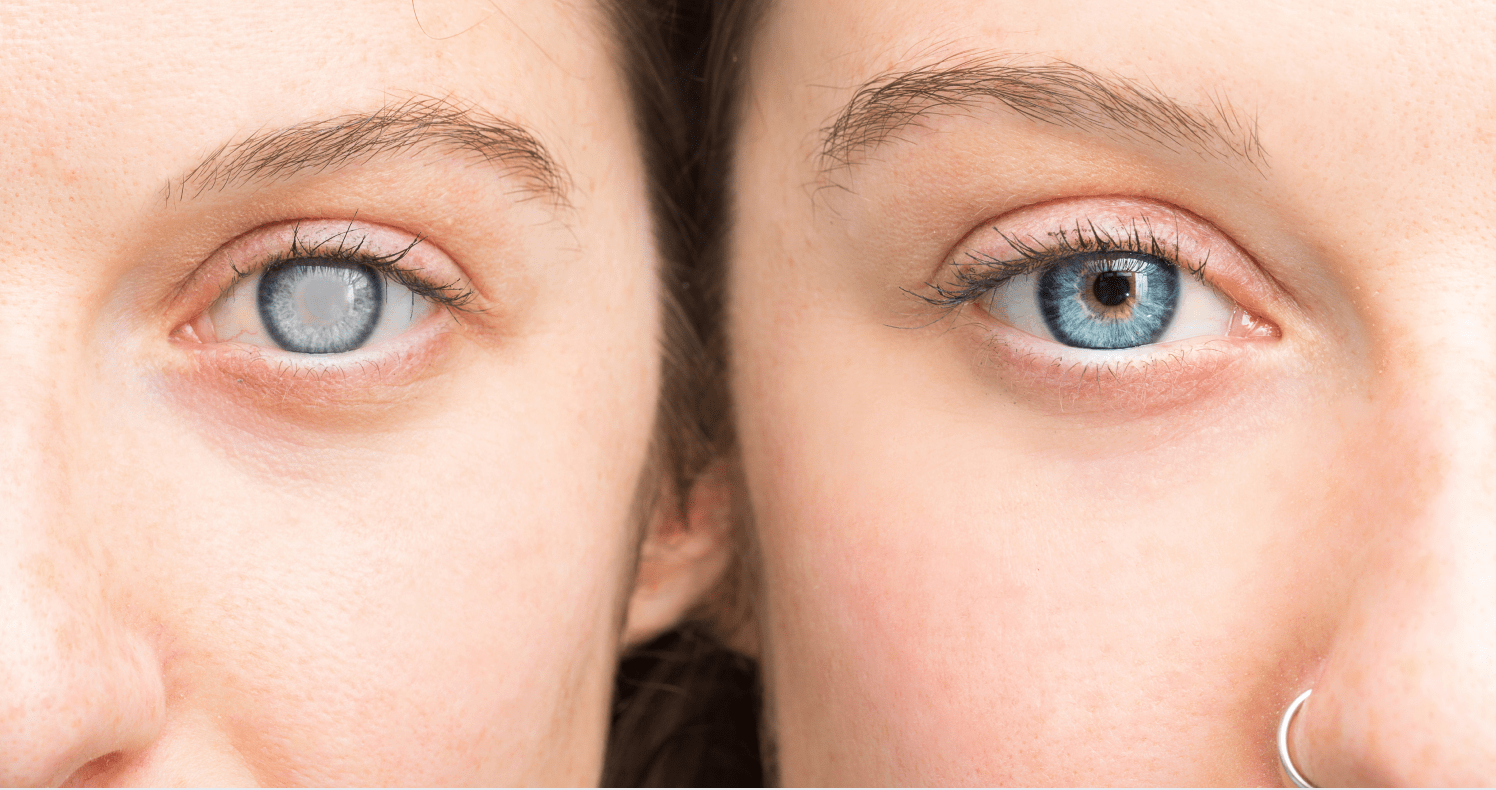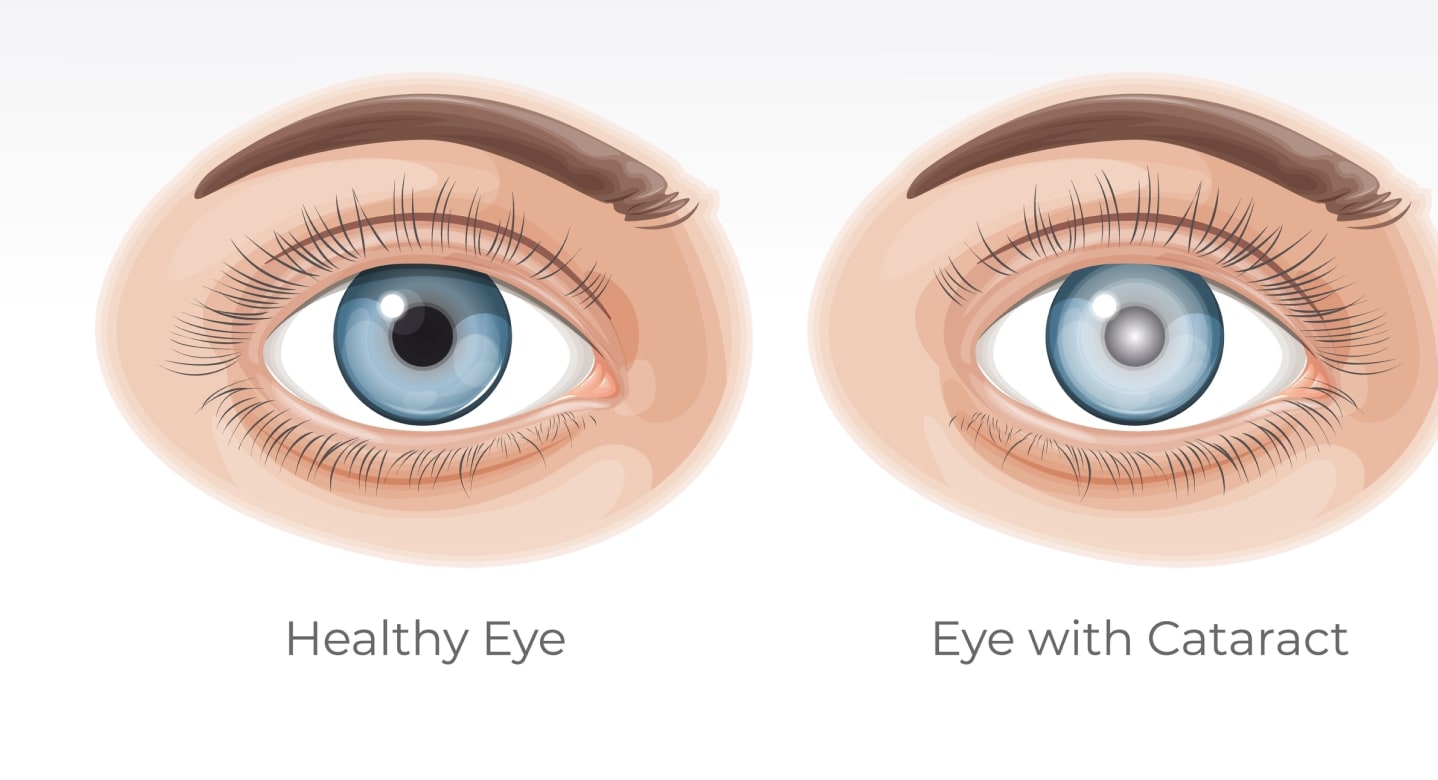What are cataracts?
Updated JAN 26, 2023 • 7 min read

Summary in 30 seconds:
Light should travel through clear ocular structures to then be focused on the light sensitive retina. When the normally clear lens becomes cloudy, it is known as a cataract. There are many types of cataracts which may develop at any age. Cataracts are often successfully treated with surgery.
Jump to content
1. What are cataracts?
In a young, healthy eye light travels unimpeded through clear ocular structures to then be focused on the light sensitive lining inside the eye known as the retina.
The crystalline lens (or, more simply, the lens) is a slightly flattened marble shaped structure responsible in part for helping to focus the eye. When the lens becomes cloudy, yellow and/or limits the amount of light that travels through it, it is known as a cataract. When cataracts are present, vision becomes more difficult with symptoms of glare, haziness, cloudy or dim vision. Cataracts may occur throughout one’s life from birth through old age.
What are age-related cataracts?
Most cataracts form slowly over time, so they are associated with aging. From the time of the eye’s lens formation, the lens continues to add layers of cells. These cells do not shed or slough off. Instead, as additional layers are created, the lens becomes more compact, increasing in size and density.
One function of the lens is the absorption of UV radiation. There is oxidative stress on the lens related to the absorption of UV radiation. However, by performing this function, the lens acts to protect the light-sensitive retina, especially the macula. The macula allows us to be able to see faces, read, and see details so important for quality vision.
Over time, lens metabolism, altered lens protein structure, UV radiation, and cumulative oxidative stress induces changes in the lens that lead to age-related cataract formation [3].

Changes in the eye’s lens:
Most people notice beginning in their 40s that it becomes increasingly more difficult to change focus from distance vision to reading distance. As the lens increases in density, the eye gradually loses its ability to change focus. Presbyopia refers to the eye not being able to change focus. (Hence the need for bifocals, reading glasses or longer arms!)
One function of the lens is the absorption of UV radiation. There is oxidative stress on the lens related to the absorption of UV radiation. However, by performing this function, the lens acts to protect the light-sensitive retina, especially the macula. The macula allows us to be able to see faces, read, and see details so important for quality vision.
Over time, lens metabolism, altered lens protein structure, UV radiation, and cumulative oxidative stress induces changes in the lens that lead to age-related cataract formation [3].
The two common types of age-related cataracts.
There are two common types of age-related cataracts which describe the location within the lens: nuclear and cortical.
- Nuclear cataracts are located in the center of the lens, and give the center of the lens a yellow to brown color which can affect color perception especially dimming reds, blues and purples. As a nuclear cataract progresses, the center of the lens becomes more dense causing the lens to increase power. When this happens farsighted individuals will notice a temporary improvement in their distance vision.
- Cortical cataracts are located in the peripheral lens, and form like spokes on a bicycle wheel. These cataracts do not have as much visual disturbance early on. Later in their progression glare, halos around lights and decreased night vision become more problematic.
What are other causes of cataracts?
- Traumatic cataracts: Trauma to the lens can precipitate cataract formation in the injured eye, and may be related to a blunt force injury, an auto accident, a fist fight or even as a side effect of a necessary eye surgery. Traumatic cataracts often have a rosette appearance.
- Underlying health conditions: These increase the risk for developing cataracts including diabetes and high blood pressure. Also, the long term use of corticosteroids and intraocular infection increase the risk of developing cataracts located on the backside of the lens/ This is known as a posterior subcapsular cataract (PSC). PSC cataracts increase difficulties with glare and reading.
- UV rays: Ultraviolet (UV) UV-B light rays have wavelengths between 280nm and 315nm and have more energy than the longer wavelengths of UV-A, which range between 315nm and 400nm. The higher energy UV-B rays are mostly absorbed by the cornea. The eyes need to be protected from UV-B.
For example, skiing at high altitude without adequate UV-B protection can lead to snow blindness (photokeratitis). The lower energy UV-A rays are able to reach deeper into the eye, mostly being absorbed by the lens. The cumulative exposure of UV-A increases the risk of cataract formation. It is important to protect the eyes from both UV-A and UV-B light since UV damage to the lens (and eyes) is developed over time [4].
- Smoking, alcohol & nutrition: Lifestyle choices can increase the risk for developing cataracts including smoking and excessive alcohol consumption.
Nutritional deficiencies also play a role in the risk of cataract formation. The lens is bathed in aqueous fluid in front of the lens and vitreous gel behind the lens. Vitamin C, lutein and zeaxanthin, which act to quench oxidative stress, are found in the lens and these fluids. These nutrients must be acquired through foods or nutritional supplementation. A colorful diet of fruits, vegetables and cold-water fish support general eye wellness [5,6]. - Congenital cataracts: This type is present at birth or shortly thereafter but may even develop during childhood. Often these are associated with genetic conditions, birth defects, intrauterine infection, or trauma. Proper vision development requires a clear image to be sent to the brain in an infant. Not all congenital cataracts interfere with vision. But, if the cataract does interfere with vision, steps should be taken to avoid lifelong implications.

Information about cataract surgery
After your doctor has diagnosed cataracts as the cause for vision loss, there are several considerations to take into account.
- Are the cataracts causing enough visual disability to consider surgery?
- Are there other eye conditions present such as macular degeneration and/or glaucoma?
Proceeding with cataract surgery.
If the decision is to go forth with cataract removal, for the best surgical outcome, the ocular surface needs to be in good shape. The ocular surface and lids need to be evaluated and treated, if necessary.
It is important to address dry eye before surgery. Some of the recommendations may include: non-preserved artificial tears, warm compresses, topical steroid drops, topical cyclosporine A drops, punctal plugs, and oral nutritional supplements.
In preparation for cataract surgery, measurements are taken to decide the best intraocular lens (IOL) power to replace the cataractous lens. There are options for the type and design of the IOL. A monofocal lens will set clear vision at one distance. Frequently vision is set to be clear far away, and then reading glasses are used for close vision. There are multifocal IOL designs that function with the same intent as bifocals.
Another option is to set vision in one eye for distance vision and the other for close vision. To be sure that this option will be visually tolerated, a trial using contact lenses will help to demonstrate whether or not this will work.
Post-surgery.
Cataract surgery is performed in an outpatient facility or a hospital. After the surgery, a shield will be placed over the eye for protection. Often the eye will be evaluated one day post surgery, one week then one month. Follow the surgeon’s directions for post surgical drop instillation.
Typically these drops include an antibiotic, a steroid, and an NSAID. An eye shield is worn at night to help to keep the eye from being injured while sleeping. Avoid getting soap or water in the healing eye. The eyes should not be rubbed. Your doctor will advise when lifting, and exercise may begin again.
Summary
Removing cataracts can greatly enhance the quality of vision and life. Improved vision may even decrease the risk of falls and car accidents. One of the great benefits after cataract surgery today, is that clear distant and near vision without glasses is possible.
To decrease the risk of developing cataracts, use glasses and sunglasses that offer UV light protection appropriate for the situation, be it skiing, a day at the beach, or playing golf. Start UV protection in childhood. Also, a healthy diet that includes lots of colorful fruits, vegetables and cold water fish like salmon supports general eye wellness.
As with any surgery, there are inherent risks and possible complications. So, the decision to have cataract surgery should be well thought out and discussed with your doctor.
See what our customers
have to say about us.
Published June 28, 2022|Updated January 26, 2023
SOURCES

 Oversized
Oversized
 Aviator
Aviator
 Wayfarer
Wayfarer
 Rectangle
Rectangle
 Cat Eye
Cat Eye
 Round
Round

